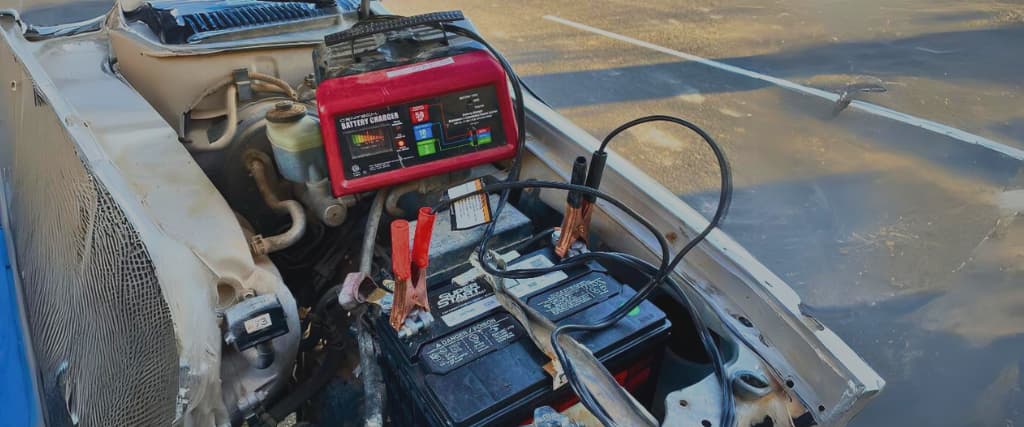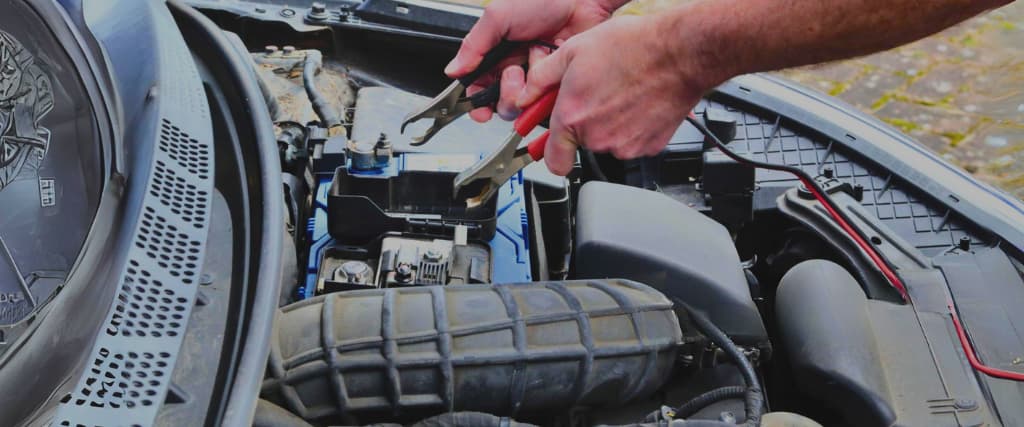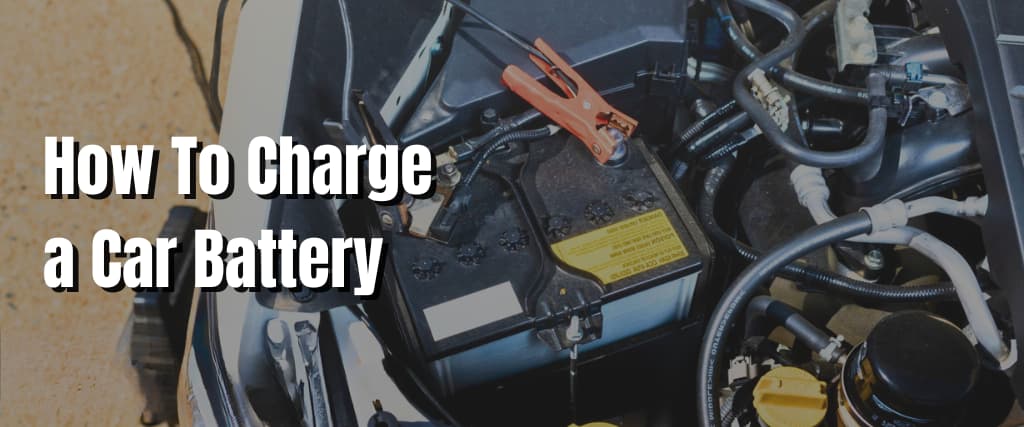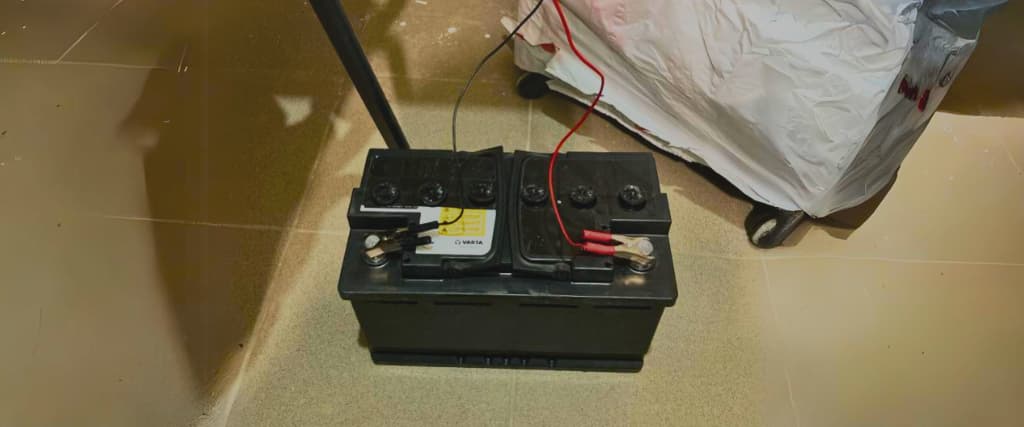Car batteries do far more than power your infotainment system and AC system. They also help your engine start and ensure your car’s computerised components have plenty of energy to continue functioning correctly.
So when your dashboard battery light turns on, it’s crucial to check your battery’s power levels and recharge it if necessary. But if you’ve never checked or charged your vehicle’s battery, you might not know where to start.
In this article, we’ll explain how to charge a car battery and how to check a battery’s power levels. We’ll also discuss seeking professional help when your car battery refuses to accept or produce a charge.
How To Test a Car Battery’s Voltage

The number of volts your car battery emits indicates its power levels and overall condition. When a battery outputs a below-average voltage, your vehicle responds by switching on the dashboard’s “check battery” light.
Before charging your battery, test the voltage. You can use a voltmeter or car battery tester device for this process. A car battery tester may be easier to use if you’re unfamiliar with average battery voltage levels.
To test your car battery’s voltage with either of these devices, you’ll want to:
- Ensure everything in your car is turned off (engine, radio, etc.)
- Power on your voltmeter or car battery tester
- Touch the tip of the red testing cable (positive) to the positive terminal of the battery
- Touch the tip of the black testing cable (negative) to the negative terminal of the battery
- Check the testing device’s reading to determine the battery’s at-rest voltage
A charged battery in great condition typically shows a voltage reading of 12v or higher. If the reading is lower, it’s time to charge your car battery.
How To Charge a Car Battery
Fortunately, recharging your car battery is a straightforward, four-step process:
- Locate your car battery charger
- Adjust the charger’s settings
- Connect the positive and negative cables
- Power on the charger
Let’s explore these steps in more detail to help you charge your vehicle’s battery quickly and safely.
Locate Your Car Battery Charger
Naturally, the first step of charging your car’s battery is locating your battery charger. This might seem like an obvious step, but it’s crucial to differentiate between the two types of chargers available:
- At-home car battery chargers, and
- Portable car battery chargers
Both are useful ways to give your car battery some juice, but at-home chargers are better at producing a full charge. In comparison, portable battery chargers (also called portable jump starters) are better for when you need to charge your car’s battery away from home.
After you’ve chosen the best charger for the situation, it’s time to turn it on and adjust its settings.
Adjust the Charger’s Settings
When charging a car battery, it’s best to choose “long-term charge” or low-power settings. Doing so helps protect your battery from stress, helping to keep it in tip-top shape and preventing explosions or unwanted damage to your car battery.
Power on your at-home charger and ensure it’s set to low-power settings before connecting any cables.
If you’re using a portable charger, you may not have the option to change these settings. In this car, refer to the portable charger’s manufacturer’s guidelines before connecting it to your battery. After adjusting your charger’s settings, turn the charger off.
Connect the Positive and Negative Cables

Now it’s time to connect the charger’s positive and negative cables to your car battery’s terminals.
The red cable is positive, and the black cable is negative. Your battery’s terminals should display their charge on the top of the terminal caps or the terminals themselves.
Always connect the positive cable first to reduce shock risk.
Power on the Charger
When both cables are firmly attached to the battery terminals (via metal clamps), power on the charger again and double-check the settings.
From this point forward, you’ll only need to wait!
The time it takes for a car battery to reach full charge varies depending on:
- The battery’s current voltage
- The size of the battery
- The type of charger you’re using
The larger the battery and lower the voltage, the more time it will take to reach full charge. Additionally, at-home car battery chargers that plug into a wall outlet provide more power than portable handheld chargers.
Portable chargers may be able to jumpstart your battery or charge it for up to four hours (helping you get back on the road in emergencies). At-home battery chargers typically take up to a day to fully charge batteries.
Use a charger with a built-in automatic shutoff feature to avoid overcharging your battery. Otherwise, you’ll want to check on your battery every eight hours and use your voltmeter or battery tester device to check its voltage.
Seeking Professional Help
If you don’t feel comfortable charging your car battery, you can also seek professional help from local car mechanics.
The only potential drawback of this option is having to tow your vehicle to the nearest autobody shop, as a car with a dead or dying battery may not be safe to drive (or capable of starting up).
Additionally, a car battery may not accept a charge, necessitating battery replacement. You can choose to replace your vehicle’s battery yourself or seek professional battery replacement services.
Generally, having an experienced mechanic replace your battery is the safer and more convenient option.
Google Maps is an excellent resource for finding mechanics and auto body shops in your area. Search for mechanics and autobody shops near you by typing “car battery replacement” or “mechanic” into the topmost search bar, then hit “Enter” or “Search.”
You’ll then see a list of nearby businesses that meet your search terms. Each option will display a customer rating, helping you select a trustworthy service provider!
Final Thoughts
When your vehicle’s car battery light has switched on, you’ll first want to check the battery’s power levels. If they’re low, you charge the battery with a portable or at-home charger.
If you’d prefer, you can also drive or tow your car to a mechanic for professional charging or battery replacement.



